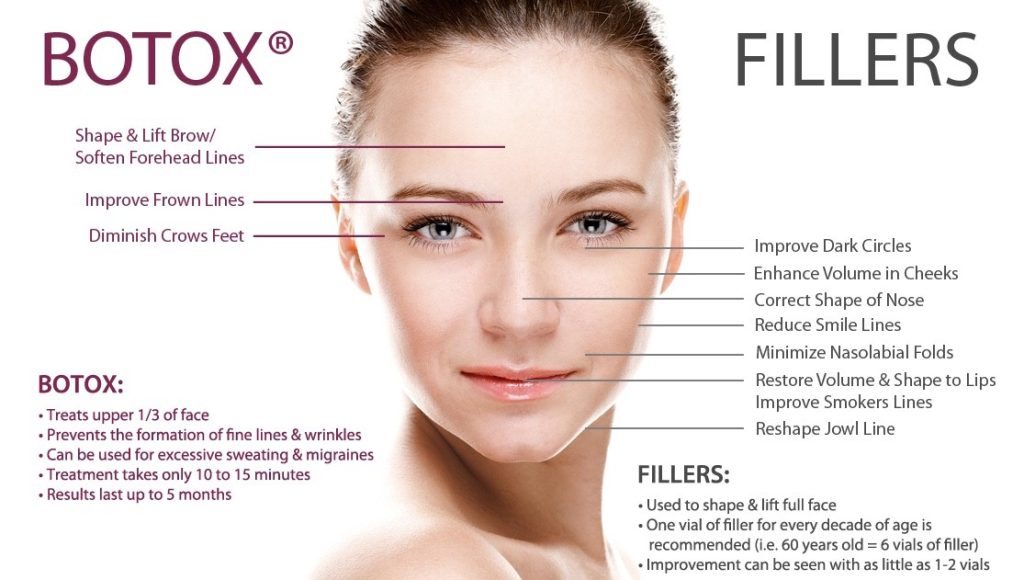Understanding Botox and Dermal Fillers

Understanding Botox and Dermal Fillers
Introduction
Botox and dermal fillers are among the most popular non-surgical cosmetic treatments in the world today. They offer a quick, effective way to reduce the signs of aging, enhance facial features, and improve overall skin appearance. Despite their popularity, there is often confusion about what these treatments involve, how they differ, and what results they can deliver. This comprehensive guide will help you understand the nuances of Botox and dermal fillers, their benefits, risks, and how to determine which treatment is right for you.
What Are Botox and Dermal Fillers?
Botox: The Muscle Relaxer
Botox, derived from the bacterium Clostridium botulinum, is a neuromodulator that temporarily paralyzes muscles. It works by blocking nerve signals that cause muscle contractions, which leads to a reduction in the appearance of dynamic wrinkles—those caused by facial expressions such as frowning, squinting, or smiling. Common areas for Botox treatment include the forehead, between the eyebrows (frown lines), and around the eyes (crow’s feet).
Botox is not just used for cosmetic purposes but also for medical conditions such as chronic migraines, excessive sweating (hyperhidrosis), and certain muscular disorders. Its versatility and effectiveness have made it a cornerstone of modern medical aesthetics.
Dermal Fillers: The Volume Enhancers
Dermal fillers are injectable substances used to restore lost volume, smooth out wrinkles, and enhance facial contours. The most common type of filler is made from hyaluronic acid, a naturally occurring substance in the skin that helps maintain hydration and plumpness. Other types of fillers include calcium hydroxylapatite, poly-L-lactic acid, and polymethylmethacrylate (PMMA), each offering unique benefits and lasting effects.
Dermal fillers are particularly effective for treating static wrinkles, which are visible even when the face is at rest. They are also used to augment features such as the lips, cheeks, and jawline, providing a more youthful and balanced appearance.
The Benefits of Botox and Dermal Fillers
Immediate and Long-Lasting Results
One of the most significant advantages of Botox and dermal fillers is the immediate improvement they offer. Botox typically takes a few days to show its full effect, with results lasting between three to four months. Dermal fillers, on the other hand, provide instant volume and smoothness, with effects lasting from six months to two years, depending on the type of filler used and the area treated.
Non-Surgical and Minimally Invasive
Both Botox and dermal fillers are non-surgical treatments, meaning they require no incisions, stitches, or general anesthesia. The procedures are performed in a clinical setting, usually within 30 to 60 minutes. Most patients experience minimal downtime, with some returning to their regular activities immediately after treatment. This convenience makes Botox and fillers ideal for those with busy lifestyles or those seeking a quick rejuvenation before a special event.
Customizable Treatments
Every face is unique, and one of the strengths of Botox and dermal fillers is their versatility. Treatments can be customized to address individual concerns, whether it’s reducing the appearance of crow’s feet, lifting sagging cheeks, or enhancing the lips. By carefully selecting the right areas for injection and the appropriate type of filler, practitioners can achieve natural-looking results that enhance the patient’s features without looking overdone.
Preventative Aging
Botox is not just for those looking to reverse the signs of aging—it can also be used preventatively. By starting Botox treatments in their late 20s or early 30s, individuals can prevent the formation of deep lines and wrinkles. This preventative approach helps maintain a youthful appearance over time, reducing the need for more extensive treatments as they age.
Understanding the Differences Between Botox and Dermal Fillers
Targeted Concerns
The primary difference between Botox and dermal fillers lies in what they treat. Botox is most effective for treating dynamic wrinkles—those that form as a result of repetitive muscle movements, such as frown lines, forehead lines, and crow’s feet. By relaxing the underlying muscles, Botox smooths the overlying skin, reducing the appearance of these wrinkles.
Dermal fillers, on the other hand, are best suited for addressing volume loss and static wrinkles—those that are present even when the face is at rest. As we age, the skin loses collagen, fat, and elasticity, leading to a hollow or sunken appearance in areas like the cheeks, temples, and under-eye regions. Fillers restore this lost volume, plumping up the skin and smoothing out wrinkles.
Duration of Results
Botox and dermal fillers also differ in how long their results last. Botox results typically last three to four months, after which muscle activity gradually returns, and wrinkles may reappear. Regular maintenance treatments are necessary to sustain the desired effect.
Dermal fillers can last anywhere from six months to two years, depending on the type of filler used and the area treated. For example, hyaluronic acid fillers usually last between six and 18 months, while calcium hydroxylapatite and poly-L-lactic acid fillers can last up to two years. Over time, the body naturally absorbs the filler material, and touch-up treatments are needed to maintain the results.
Composition and Mechanism of Action
Botox is composed of botulinum toxin type A, a neurotoxin that temporarily paralyzes muscles by blocking the release of acetylcholine, a neurotransmitter that signals muscle contraction. This mechanism of action is why Botox is so effective at treating dynamic wrinkles.
Dermal fillers, however, work by physically adding volume beneath the skin. The most common fillers are made of hyaluronic acid, a substance that attracts water and hydrates the skin. Other fillers, like calcium hydroxylapatite, work by stimulating collagen production in addition to adding volume. The choice of filler depends on the area being treated and the desired outcome.
Combining Botox and Dermal Fillers for Optimal Results
While Botox and dermal fillers are effective on their own, many patients benefit from a combination of both treatments. This approach allows for comprehensive facial rejuvenation, targeting multiple signs of aging at once.
The Liquid Facelift
A combination of Botox and dermal fillers is often referred to as a “liquid facelift.” This non-surgical treatment addresses a variety of aging concerns, including:
- Dynamic Wrinkles: Botox smooths out lines caused by muscle movement, such as forehead lines, frown lines, and crow’s feet.
- Volume Loss: Dermal fillers restore lost volume in areas like the cheeks, temples, and under-eye hollows, providing a more youthful and lifted appearance.
- Facial Contouring: Fillers can also enhance facial features, such as defining the jawline, augmenting the lips, or reshaping the nose without surgery.
The liquid facelift offers the benefits of a traditional facelift without the need for surgery, anesthesia, or extensive downtime. The results are natural-looking and can be customized to suit each patient’s individual needs and aesthetic goals.
Maintenance and Follow-Up
To maintain the results of Botox and dermal fillers, regular follow-up treatments are recommended. The frequency of these treatments will depend on the type of filler used, the areas treated, and the patient’s individual response to the products. A skilled practitioner will create a personalized treatment plan to ensure long-lasting results and minimal disruption to your routine.
Choosing the Right Practitioner
The success of Botox and dermal filler treatments largely depends on the skill and experience of the practitioner. Choosing a qualified, board-certified dermatologist, plastic surgeon, or aesthetic physician is essential for achieving safe and effective results.
What to Look For in a Practitioner
- Credentials and Training: Ensure that your practitioner is board-certified and has specialized training in injectables. They should have a deep understanding of facial anatomy and the specific techniques required for Botox and dermal fillers.
- Experience: Look for a practitioner with extensive experience performing these treatments. Ask to see before-and-after photos of previous patients and read reviews or testimonials to gauge their level of expertise.
- Personalized Consultations: A reputable practitioner will offer a thorough consultation before any treatment, discussing your goals, assessing your facial structure, and recommending a personalized treatment plan.
Safety Considerations
Safety is paramount in medical aesthetics. Botox and dermal fillers should only be administered by trained professionals in a sterile, clinical environment. Be wary of “bargain” treatments or unlicensed providers, as these can lead to complications, including infections, asymmetry, or unsatisfactory results.
Before opting for Botox or dermal fillers, it’s crucial to ensure you’re well-informed about the safety standards in aesthetic clinics. For more on this, explore our article on Safety First – Understanding Safety in Medical Aesthetic Clinics.
Conclusion
Botox and dermal fillers are powerful tools in the world of medical aesthetics, offering effective, non-surgical solutions for a wide range of cosmetic concerns. By understanding the differences between these treatments and how they work, you can make an informed decision about which option—or combination of options—is right for you.
Whether you’re looking to smooth out wrinkles, restore lost volume, or enhance your facial features, Botox and dermal fillers can help you achieve your aesthetic goals. The key to successful treatment lies in choosing a qualified practitioner, following their advice, and maintaining a regular treatment schedule.
With the right approach, Botox and dermal fillers can deliver natural-looking, long-lasting results that leave you looking and feeling your best.
1. American Society for Aesthetic Plastic Surgery (ASAPS)
- Leading organization dedicated to advancing the field of aesthetic plastic surgery, offering resources for patients and professionals.
- https://www.surgery.org/
2. American Academy of Dermatology (AAD)
- Comprehensive resource for dermatology, providing information on skin care, conditions, and the latest treatments.
- https://www.aad.org/
3. RealSelf
- Trusted platform where patients can find reviews, cost information, and expert advice on cosmetic treatments.
- https://www.realself.com/
4. American Board of Cosmetic Surgery (ABCS)
- Accredited board providing certification and education to ensure the highest standards in cosmetic surgery.
- https://www.americanboardcosmeticsurgery.org/
5. International Society of Aesthetic Plastic Surgery (ISAPS)
- Global leader in aesthetic plastic surgery education and practice, representing over 100 countries.
- https://www.isaps.org/
6. The British Association of Aesthetic Plastic Surgeons (BAAPS)
- UK’s leading authority in aesthetic plastic surgery, providing safety information and professional guidelines.
- https://baaps.org.uk/
7. Medscape Dermatology
- Extensive resource for dermatology professionals, featuring the latest news, research, and clinical guidelines.
- Website Link: https://www.medscape.com/dermatology
8. Journal of Cosmetic Dermatology
- Peer-reviewed journal providing the latest research and advancements in cosmetic dermatology.
- https://onlinelibrary.wiley.com/journal/14732165
9. Plastic and Reconstructive Surgery Journal
- Esteemed medical journal covering all aspects of plastic and reconstructive surgery, featuring groundbreaking research.
- https://journals.lww.com/plasreconsurg/pages/default.aspx
10. National Institute for Health and Care Excellence (NICE)
- UK-based organization providing evidence-based guidance and standards for health and care, including medical aesthetics.
- https://www.nice.org.uk/
Contact us to receive a free personalized skin consultation or call us (514) 651-CMEC (2632)
